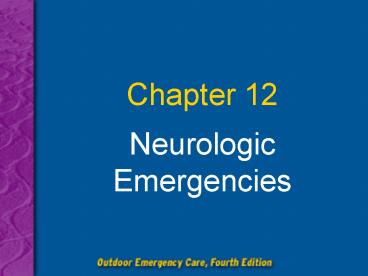Neurologic Emergencies - PowerPoint PPT Presentation
1 / 27
Title:
Neurologic Emergencies
Description:
Describe the causes of stroke, including the two major types. ... Drug overdose. Unrecognized head injury. Brain infection. Body temperature abnormalities ... – PowerPoint PPT presentation
Number of Views:3078
Avg rating:3.0/5.0
Title: Neurologic Emergencies
1
Chapter 12
- Neurologic Emergencies
2
Objectives (1 of 3)
- Describe the causes of stroke, including the two
major types. - Obtain and interpret the key vital signs in the
stroke patient, including the time of onset of
the symptoms. - Identify the signs and symptoms of stroke
- Describe the significance of a transient ischemic
attack (TIA).
3
Objectives (2 of 3)
- Define seizure, including the two major types of
seizure. - Explain the importance of recognizing seizures.
- Discuss the differences between unresponsiveness
and disorientation.
4
Objectives (3 of 3)
- Demonstrate the steps in the emergency care for
the patient who has had a stroke. - Demonstrate testing for aphasia, facial weakness,
and motor weakness. - Demonstrate the steps in the emergency care for
the patient who has had a seizure. - Demonstrate the steps in the emergency care for
the patient who is unresponsive.
5
Brain Structure and Function
6
The Spinal Cord
7
Common Causes of Brain Disorder
- Cerebrovasuclar accident (CVA)
- Interruption of blood flow to the brain that
results in the loss of brain function - Stroke
- The loss of brain function that results from a CVA
8
Hemorrhagic Stroke
- Results from bleeding in the brain
- Arterial rupture
- High blood pressure is a risk factor.
- Some people are born with aneurysms.
9
Ischemic Stroke
- Results when blood flow to a particular part of
the brain is cut off by a blockage inside a blood
vessel - Thrombosis
- Clotting of the cerebral arteries
- Cerebral embolism
- Blockage by a clot formed elsewhere in the body
10
Transient Ischemic Attack (TIA)
- A TIA is a mini-stroke.
- Stroke symptoms go away within 24 hours.
- Every TIA is an emergency.
- TIA may be a warning sign of a larger stroke.
- Patients with possible TIA should be evaluated by
a physician.
11
Seizures
- Generalized (grand mal) seizure
- Unconsciousness and generalized severe twitching
of the bodys muscles that lasts several minutes - Petit mal seizure
- Seizure characterized by a brief lapse of
attention
12
Characteristics of Seizures
- Seizures may occur on one side or gradually
progress to a generalized seizure. - Usually last 3 to 5 minutes and are followed by
postictal state - Seizures recurring every few minutes are known as
status epilepticus.
13
Causes of Seizures
- Congenital (epilepsy)
- Structural problems in the brain (tumor, scar,
infection) - Metabolic disorders
- Chemical disorders (poison, drugs)
- Sudden high fever (febrile)
14
Recognizing Seizures
- Cyanosis
- Abnormal breathing
- Possible head injury
- Loss of bowel and bladder control
- Severe muscle twitching
- Post-seizure state of unresponsiveness with deep
and labored respirations
15
Postictal State
- Patient may have labored breathing.
- Patient may have hemiparesis weakness on one
side of the body. - Patient may be lethargic, confused, or combative.
- Consider underlying conditions.
- Hypoglycemia
- Infection
16
Altered Mental Status (AMS)
- Hypoglycemia
- Hypoxemia
- Intoxication
- Drug overdose
- Unrecognized head injury
- Brain infection
- Body temperature abnormalities
- Brain tumors
- Glandular abnormalities
- Poisoning
17
Hypoglycemia
- Can mimic stroke or seizure
- Will not generally improve after a seizure
- May exhibit a lower level of responsiveness than
a stroke patient - Look for medical bracelet or medications that
indicate diabetes.
18
Signs and Symptoms of Brain Disorders
- Many different disorders can affect
- Level of consciousness
- Speech
- Voluntary muscle control
19
Signs and Symptoms of Stroke
- Left Hemisphere
- Aphasia Inability to speak or understand speech
- Receptive aphasia Ability to speak, but unable
to understand speech - Expressive aphasia Inability to speak correctly,
but able to understand speech - Right Hemisphere
- Dysarthria Able to understand, but hard to be
understood
20
Conditions that Stroke May Mimic
- Hypoglycemia
- Postictal state
- Subdural or epidural bleeding
21
Assessing the Stroke Patient
- Initial assessment
- Check and care for ABCs.
- Obtain history if possible.
- Administer oxygen and manage airway.
- Focused history and physical exam
- Perform neurologic exam.
- Use the Cincinnati Stroke Scale.
22
Cincinnati Stroke Scale
- Facial droop
- Abnormal if asymmetrical
- Arm drift
- Abnormal if arms do not move equally
- Speech
- Abnormal if words are slurred or confused
23
Transport Considerations
- Place the patient in a comfortable position.
- Usually on one side
- Paralyzed side down and well protected
- Elevate patients head about 6".
- Continue giving oxygen and monitor vital signs.
24
Assessing the Seizure Patient
- Initial assessment
- Focus on ABCs
- Expect rapid, deep respirations if the patient is
postictal. - Focused history and physical exam
- Obtain SAMPLE history.
- Observe patient for recurrent seizures.
25
Assessing a Patient with AMS
- Use AVPU scale to classify severity.
- Consider underlying conditions.
- Monitor for depressed respirations.
- Ensure that basic airway maneuvers are followed.
- Arrange for prompt transport to hospital, monitor
the patient.
26
Emergency Medical Carefor Stroke
- Patient needs to be evaluated by computed
tomography (CT). - Recognizing the signs and symptoms of stroke can
shorten the delay to CT. - Treatment needs to start within 3 to 6 hours of
onset.
27
Emergency Medical Carefor Seizure
- Most patients should be evaluated by a physician
after a seizure. - With severe injury, suspect spinal injury.
- Attempt to lower body temperature if febrile
seizure occurs. - Patient and family may be frightened.































